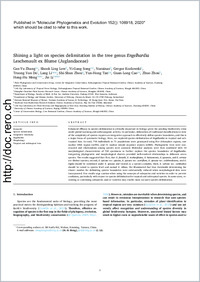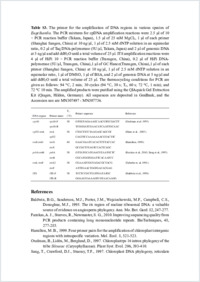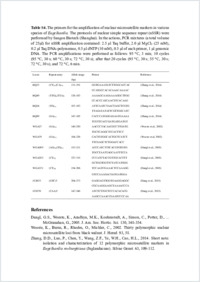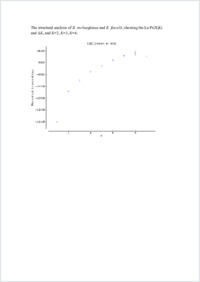Shining a light on species delimitation in the tree genus Engelhardia Leschenault ex Blume (Juglandaceae)
- Zhang, Can-Yu Plant Phylogenetics and Conservation Group, Center for Integrative Conservation, Xishuangbanna Tropical Botanical Garden, Chinese Academy of Sciences, Kunming 650023, China - University of Chinese Academy of Sciences, Beijing 100049, China
- Low, Shook Ling CAS Key Laboratory of Tropical Forest Ecology, Xishuangbanna Tropical Botanical Garden, Chinese Academy of Sciences, Mengla 666303, China
- Song, Yi-Gang Shanghai Chenshan Plant Science Research Center, Chinese Academy of Sciences, Shanghai 201602, China - Department of Biology and Botanic Garden, University of Fribourg, Chemin du Musée 10, CH-1700 Fribourg, Switzerland
- Nurainas Department of Biology, Faculty of Math. & Nat. Sci. Andalas University, Padang 25163, West Sumatra, Indonesia
- Kozlowski, Gregor Department of Biology and Botanic Garden, University of Fribourg, Chemin du Musée 10, CH-1700 Fribourg, Switzerland
- Do, Truong Van Vietnam National Museum of Nature, Vietnam Academy of Science & Technology, 18 Hoang Quoc Viet, Hanoi, Viet Nam
- Li, Lang Plant Phylogenetics and Conservation Group, Center for Integrative Conservation, Xishuangbanna Tropical Botanical Garden, Chinese Academy of Sciences, Kunming 650023, China - Southeast Asia Biodiversity Research Institute, Chinese Academy of Sciences, Nay Pyi Taw 05282, Myanmar - Center of Conservation Biology, Core Botanical Gardens, Chinese Academy of Sciences, Mengla 666303, China
- Zhou, Shi-Shun Southeast Asia Biodiversity Research Institute, Chinese Academy of Sciences, Nay Pyi Taw 05282, Myanmar
- Tan, Yun-Hong Southeast Asia Biodiversity Research Institute, Chinese Academy of Sciences, Nay Pyi Taw 05282, Myanmar - Center of Conservation Biology, Core Botanical Gardens, Chinese Academy of Sciences, Mengla 666303, China
- Cao, Guan-Long Plant Phylogenetics and Conservation Group, Center for Integrative Conservation, Xishuangbanna Tropical Botanical Garden, Chinese Academy of Sciences, Kunming 650023, China - University of Chinese Academy of Sciences, Beijing 100049, China
- Zhou, Zhuo CAS Key Laboratory for Plant Diversity and Biogeography of East Asia, Kunming Institute of Botany, Chinese Academy of Sciences, Kunming 650201, China
- Meng, Hong-Hu Plant Phylogenetics and Conservation Group, Center for Integrative Conservation, Xishuangbanna Tropical Botanical Garden, Chinese Academy of Sciences, Kunming 650023, China - Southeast Asia Biodiversity Research Institute, Chinese Academy of Sciences, Nay Pyi Taw 05282, Myanmar
- Li, Jie Plant Phylogenetics and Conservation Group, Center for Integrative Conservation, Xishuangbanna Tropical Botanical Garden, Chinese Academy of Sciences, Kunming 650023, China - Southeast Asia Biodiversity Research Institute, Chinese Academy of Sciences, Nay Pyi Taw 05282, Myanmar - Center of Conservation Biology, Core Botanical Gardens, Chinese Academy of Sciences, Mengla 666303, China
-
01.11.2020
Published in:
- Molecular Phylogenetics and Evolution. - 2020, vol. 152, p. 106918
English
Enhanced efficacy in species delimitation is critically important in biology given the pending biodiversity crisis under global warming and anthropogenic activity. In particular, delineation of traditional classifications in view of the complexity of species requires an integrative approach to effectively define species boundaries, and this is a major focus of systematic biology. Here, we explored species delimitation of Engelhardia in tropical and subtropical Asia. In total, 716 individuals in 71 populations were genotyped using five chloroplast regions, one nuclear DNA region (nrITS), and 11 nuclear simple sequence repeats (nSSR). Phylogenetic trees were constructed and relationships among species were assessed. Molecular analyses were then combined with 14 morphological characteristics of 720 specimens to further explore the species boundaries of Engelhardia. Integrating phylogenetic and morphological clusters provided well-resolved relationships to delineate seven species. The results suggested that: first, that E. fenzelii, E. roxburghiana, E. hainanensis, E. apoensis, and E. serrata are distinct species; second, E. spicata var. spicata, E. spicata var. aceriflora, E. spicata var. colebrookeana, and E. rigida should be combined under E. spicata and treated as a species complex; third, E. serrata var. cambodica should be raised to species level and named E. villosa. We illuminated that bias thresholds determining the cluster number for delimiting species boundaries were substantially reduced when morphological data were incorporated. Our results urge caution when using the concepts of subspecies and varieties in order to prevent confusion, particularly with respect to species delimitation for tropical and subtropical species. In some cases, re-ranking or combining subspecies and/or varieties may enable more accurate species delimitation.
- Faculty
- Faculté des sciences et de médecine
- Department
- Département de Biologie
- Language
-
- English
- Classification
- Biological sciences
- License
-
License undefined
- Identifiers
-
- RERO DOC 329615
- DOI 10.1016/j.ympev.2020.106918
- Persistent URL
- https://folia.unifr.ch/unifr/documents/309008
Other files
Statistics
Document views: 142
File downloads:
- pdf: 340
- Supplementary material: 129
- Texte intégral: 140
- Texte intégral: 165
- Texte intégral: 105
- Texte intégral: 143
- Texte intégral: 104
- Texte intégral: 118
- Regions.txt: 47
- Ribotypes.txt: 42
- SR_Haplotypes.txt: 34
- SR_RawData.txt: 47








